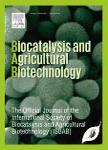版权所有:内蒙古大学图书馆 技术提供:维普资讯• 智图
内蒙古自治区呼和浩特市赛罕区大学西街235号 邮编: 010021

作者机构:Univ Teknol Malaysia Fac Sci Dept Biosci Johor Baharu 81310 Johor Malaysia Dept Chem Malaysia Johor Jalan Abdul Samad Johor Baharu 80100 Johor Malaysia Univ Teknol Malaysia Ibnu Sina Inst Sci & Ind Res ISI SIR Ctr Sustainable Nanomat CSNano Utm 81310 Johor Malaysia Univ Teknol Malaysia Fac Sci Dept Chem Johor Baharu 81310 Johor Malaysia
出 版 物:《BIOCATALYSIS AND AGRICULTURAL BIOTECHNOLOGY》 (生物催化与农业生物技术)
年 卷 期:2022年第44卷
学科分类:08[工学] 09[农学] 0901[农学-作物学] 0836[工学-生物工程] 090102[农学-作物遗传育种]
基 金:Ministry of Higher Education Universiti Teknologi Malaysia [06G71, 06G72] UTM-TDR project FRGS/1/2020/STG04/UTM/02/3 5F291
主 题:F deltoidea Plant organs Biosynthesis Silver nanoparticle
摘 要:Biosynthesis of silver nanoparticles (AgNP) using plant extracts is considered as an advanced method of synthesising AgNP using the green method. Although the leaf and the root of Ficus del-toidea Jack var. kunstleri (King) Corner (Mas Cotek) are known to have medicinal benefits, the study on its organs (leaf, stem, fig and root) to synthesise AgNP is still scarce. Therefore, this study determined the optimal synthesising conditions for AgNP-Leaf, AgNP-Stem, AgNP-Fig, and AgNP-Root, involving the volumes of plant extracts (1.0, 1.0, 0.8 and 3.0 mL), reaction times (30, 21, 33 and 21 h), reaction temperatures (60, 90, 100 and 90 degrees C), and solution pH (10, 12, 10 and 12). Thermogravimetric analysis (TGA) discovered that AgNP-Stem had the highest organic de-composition. All biosynthesised AgNPs exhibited spherical and crystal structures, with the parti-cle sizes in the order of AgNP-Root (15.4 +/- 3.4 nm) AgNP-Stem (20.5 +/- 2.4 nm) AgNP-Fig (21.3 +/- 4.2 nm) AgNP-Leaf (22.9 +/- 4.3 nm), as measured by transmission electron mi-croscope (TEM). Meanwhile, in the disc diffusion technique (DDT) and minimum inhibitory/bac-tericidal concentration (MIC/MBC) analyses, AgNP-Root exhibited more significant antibacterial activity against Escherichia coli (ATCC 11229) and Staphylococcus aureus (ATCC 6538) bacteria compared to other organs. Visible damage was found on the bacterial wall of S. aureus treated with AgNP-Stem when observed using field emission scanning electron microscopy (FESEM). Hence, the phytochemical compounds found in the F. deltoidea organs significantly influenced the characteristics of AgNP and subsequently impacted the antibacterial activity.